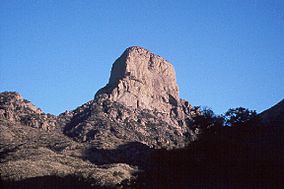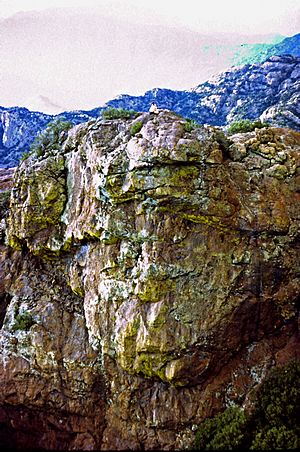Baboquivari Peak Wilderness facts for kids
Quick facts for kids Baboquivari Peak Wilderness |
|
|---|---|
|
IUCN Category Ib (Wilderness Area)
|
|

View of the east face of Baboquivari Peak
|
|
| Location | Pima County, Arizona, U.S. |
| Nearest city | Tucson, Arizona |
| Area | 2,065 acres (836 ha) |
| Designated | 1990 |
| Governing body | Bureau of Land Management |
The Baboquivari Peak Wilderness is a special natural area in Arizona, USA. It covers about 2,065-acre (8 km2) of land. This wilderness is part of a system that protects wild places. It is located about 50 miles (80 km) southwest of Tucson, Arizona. The Bureau of Land Management takes care of this area.
The United States Congress officially made Baboquivari Peak a wilderness area in 1990. It is the smallest protected wilderness area in Arizona. To the west of the peak is the large 2,900,000-acre (12,000 km2) Tohono O'odham Nation. This is the second largest Native American reservation in the United States.
Baboquivari Peak stands tall at 7,730 feet (2,356 meters). It is a popular spot for rock climbers and visitors. You can even see it from the Kitt Peak National Observatory in the distance. Long ago, this mountain was known as a great place to find flint. Flint is a type of rock used to make tools and arrow points. The name "Baboquivari" means "the place for the mother lode of flint."

Baboquivari Peak with part of Kitt Peak National Observatory in the foreground.
|
Many people say Baboquivari Peak Wilderness has some of the best rock climbing in Arizona. You can visit any time of year. However, summer afternoons are often too hot for hiking. In winter, snow can sometimes fall on the highest parts of the peak. People have also seen jaguars in the Baboquivari Mountains in recent years.
Cultural Importance

Baboquivari Peak is a very sacred place for the Tohono O'odham people. They believe it is the center of their world. It is also thought to be the home of their creator, I'itoi. According to their legends, I'itoi lives in a cave at the base of the mountain.
The O'odham people see this mountain as the "navel of the world." They believe it is where the earth opened up and their people came out after a great flood. Sometimes, Baboquivari Peak is called I'Itoi Mountain. In the native O'odham language, its name is Waw Kiwulik. This means "narrow about the middle." The O'odham people believe that I'itoi still watches over them from this mountain.
A Jesuit missionary named Padre Kino wrote about Baboquivari Peak in his journals. He explored this area of the Sonoran Desert starting in 1699. He also set up Spanish Missions in the region.
Mountain Legends
The O'odham nation has a legend about Baboquivari Peak. It tells of a Spanish officer and his soldiers during the Spanish conquest. They tried to dig into the mountain. Suddenly, the ground opened up and swallowed them. This story is similar to other legends about finding hidden treasures. For example, Francisco Vázquez de Coronado searched for the Seven Cities of Cibola. He also looked for a place called Quivira, where he was told there was lots of gold.
Climbing the Peak
The first recorded time someone climbed Baboquivari Peak was on July 12, 1898. Dr. R.H. Forbes and Sr. Montoya were the first to reach the top.
Nature in the Wilderness
The Baboquivari Mountains have many interesting land features. One important one is Fresnal Canyon. You can find many different kinds of plants and animals in the Baboquivari Peak Wilderness. One unique desert tree found here is the Bursera fagaroides.




